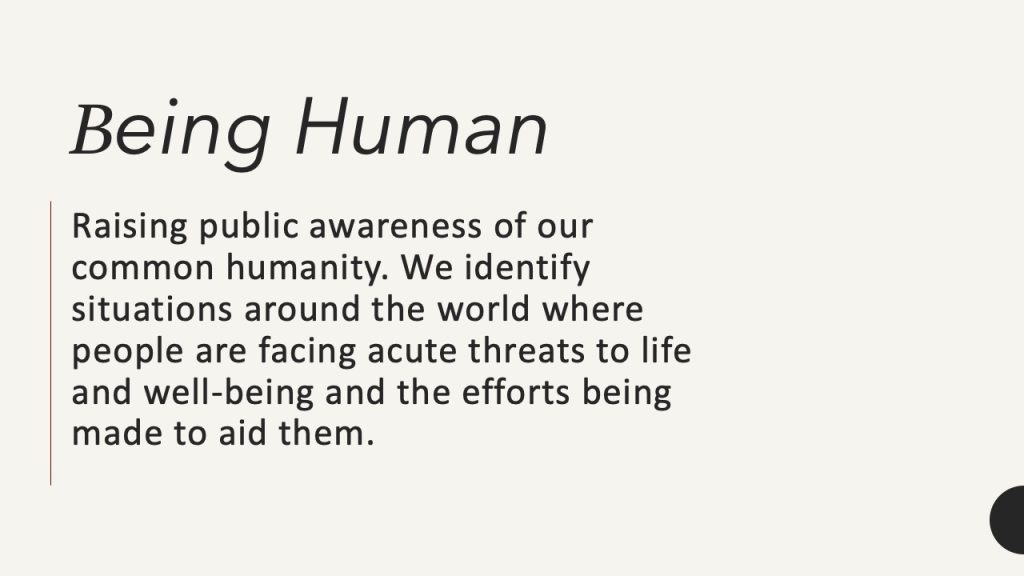Being Human: the human face of crisis

Being Human - a public service by HDPI, inc. and JMU in collaboration with WMRA
HDPI, INC. - an independent global humanitarian network.
JMU - James Madison University
WMRA - local affiliate of National Public Radio
Did you know?
Facts about humanitarian issues
(radio spot)
Being Human
stories
(radio spot)
Being Human
(Video reels social media)
"Being Human" spot submissions
Impact of conflict on Women
Impact of Conflict on Women:
Did you know?
“Women continue to pay the price of the wars of men.” This was a statement said by Sima Bahous the Executive Director of the agency UN Women. The increases in deaths during wars and in violence against women are taking place against a backdrop of increasing disregard of international law designed to protect women and children during war.
For example, recent statistics have shown that:
- Four out of every ten people who died because of conflict in 2024 were women.
- In 2023, the proportion of women killed in armed conflicts doubled compared to 2022.
- UN-verified cases of conflict-related sexual violence increased by 50 per cent.
- Every day, 500 + women and girls in conflict-affected countries die from complications related to pregnancy and childbirth. Women in places like Gaza, Sudan and Haiti, have to give birth without medical care and other necessitates, thus facing a very high risk of dying during or just after birth.
Why is this important and why does it matter?
Conflict significantly impacts women and girls in various ways. Pre-existing, structural inequalities mean that conflict and usually other disasters, affect women and girls in different ways than they affect boys and men. This is attributed to the roles women hold in society and cultural norms where they live. Conflict often exacerbates existing social, economic and cultural inequalities and creates new forms of vulnerability.
Social Protection:
- Conflict can significantly increase the risk of gender-based violence, including sexual violence used as a weapon of war. Layers of protection women normally have, like community and national and international laws, are often dismantled during conflict, leading to greater vulnerability.
- Girls may be forced into early marriages as a coping mechanism due to economic desperation. Women and girls are also vulnerable to sexual exploitation, human trafficking, forced labor, and abduction.
- Easy access to weapons and the breakdown of social structures in conflict zones can lead to an increase in interpersonal violence, including domestic violence.
Health and Well-being:
- Conflict disrupts access to essential healthcare, including sexual and reproductive services, leading to increased health risks for women and girls.
- Mental and social stress: Exposure to violence and displacement can cause significant psychological trauma.
- Women and girls are disproportionately affected by food insecurity, particularly for women of reproductive age, and increase risks of malnutrition and disease.
Livelihoods:
- In many societies there is a division of labor and women are responsible for household tasks like fetching fuel and water, growing and collecting food, and these burdens can increase during conflict as men are killed or in fighting forces. Resources also become scarce, as farm assets, crops, livestock, stores are deliberately targeted and destroyed.
- Girls may be forced to drop out of school to help with these tasks, perpetuating cycles of poverty and inequality.
- Women often have less access to resources, information, and decision-making power, hindering their ability to prepare for, respond to, and recover from disasters.
- Displaced women may lose their means of support due to loss of property and lack of access to resources or alternative income.
- Displaced women often struggle to access aid, credit from banks, education, and training, and are frequently excluded from decisions that impact their lives.
Increased Violence and Abuse:
- Disasters can amplify existing gender-based violence (GBV) and create new vulnerabilities.
- Displacement, loss of housing, and economic insecurity can increase the risk of sexual and domestic violence.
- Women may also face increased risks of exploitation and trafficking in the aftermath of a disaster.
- Women often have less access to resources, information, and decision-making power, hindering their ability to prepare for, respond to, and recover from disasters.
Funding:
Global military expenditures continue to increase as funding cuts rapidly decrease. In 2023 it reached a record $2.44 trillion. In contrast, funding for organizations and movements supporting women’s rights has been drastically cut since 2025 with the demise of US funding for all humanitarian as well as agencies supporting women’s rights. Investments in gender-based violence preventions and response has always made up less than one per cent of all humanitarian spending. (https://www.unwomen.org/sites/default/files/2025-05/at-a-breaking-point-the-impact-of-foreign-aid-cuts-on-womens-organizations-in-humanitarian-crises-worldwide-en.pdf
.
Women’s Agency and Participation:
- Women are active participants in conflict and post-conflict situations, not solely victims. They may be involved in fighting or supporting armed groups, as well as contributing to conflict resolution, peace-building and societal reconstruction.
- However, despite their important roles, women are often excluded from formal peace negotiations. In 2023, less than 10% of negotiators in peace processes were women.
- The UN Security Council, through resolution 1325, promotes the increased participation of women and the inclusion of gender perspectives in peace and security efforts
2025 Marks the 30th Anniversary of the Beijing Platform for Action whereby 189 countries of the world came together to agree on a series of actions to protect women and to ensure their equal access to recourses, economic development and political participation. A series of Security Council resolutions such as USC 1325 marked a focused commitment to women. All these commitments and actions are now on the threshold of extinction and at ‘breaking point’
as political and military powers, dominated by men, reframe a new world order. https://www.unwomen.org/sites/default/files/2025-05/at-a-breaking-point-the-impact-of-foreign-aid-cuts-on-womens-organizations-in-humanitarian-crises-worldwide-en.pdf
https://www.womenforwomen.org/conflict-response-fund.
.
- « Previous
- 1
- 2